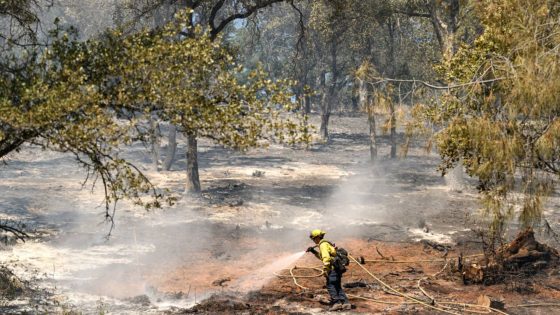A firefighter extinguishes hotspots along a hillside during the French fire in Mariposa, California on July 5, 2024. The wildfire shut down the main highway to Yosemite National Park as red flag fire warnings and high temperatures continue throughout the state.Â
Josh Edelson | AFP | Getty Images
Wildfires are blazing across western U.S. and Canada, prompting thousands to evacuate, shutting down highways and fouling the air quality over several states.
In the U.S., wildfires are raging in Oregon, California and Washington, illuminating skies with bright orange flames and haze.
In Oregon, the Durkee fire shut down Interstate 84 in the eastern part of the state in both directions Tuesday between Ontario and Baker City, the state’s Department of Transportation said, warning: “The fire is advancing rapidly towards the highway in multiple locations in the Farewell Bend area.”
The Durkee fire, the current largest wildfire in Oregon, was discovered the morning of July 17, sparked by lightning, and has since burned through over 239,000 acres and as of Wednesday is 0% contained.Â
Level three evacuations are in place in Baker and Malheur counties due to the Durkee and Cow Valley fires, with the whole town of Huntington, home to about 510 people, under level three evacuation, according to NBC affiliate KTVB of Boise, Idaho. An estimated 3,472 people are in the level 3 evacuation, meaning there’s extreme danger and locals should leave immediately. There’s currently 115 active fires in the state, according to the state’s wildfire tracker.
In Washington, a fire sparked Monday near Naches led to mandatory evacuations, another burning near Bickelton also led to evacuations and threatened a natural gas plant, and a blaze that sparked Tuesday closed a section of U.S. Route 12, according to The Associated Press.
In California, the Apache fire sparked Tuesday evening near Highway 33 and Apache Canyon Road in Ventura County in the Los Padres National Forest. The blaze, estimated to be 250 acres, led the county to order evacuations for residences on Apache Canyon Road, local fire officials said.
Firefighters douse flames while battling the Apache Fire in the early morning hours on June 25, 2024 in Oroville, California. According to Cal Fire, the fire has burned over 670 acres and is currently 15 percent contained.Â
Ethan Swope | Getty Images
The U.S. Forest Service said Tuesday that millions of acres of national forest lands across Oregon and Washington are “continuing to see record breaking dry timber conditions,” coupled with lightning storms, that spurs “rapid wildfire growth.”
Officials said the Fremont-Winema and Deschutes national forests in Oregon have surpassed 75 days without wetting rains, and 45 days without wetting rain “is widespread across the Pacific Northwest.”
Adding to conditions, much of the West has been hard hit with scorching temperatures in a prolonged heat wave the past few months.
“This is shaping up to be another monster fire year in the Pacific Northwest, and it’s just mid-July,” Ed Hiatt, Pacific Northwest assistant fire director for operations, said. He said that the agency is at Preparedness Level 5 â “the highest level of wildfire response possible in the region and nation.”
“Crews, dozers, helicopters, and incident management teams from across the nation are coming to help including folks from as far away as North Carolina and Wisconsin,” Hiatt added.
In Canada, the alpine town of Jasper and the popular Jasper National Park in the province of Alberta were evacuated as multiple wildfires blazed in the park.
The critical red alert to evacuate was issued late Monday evening warning of a wildfire south of the town.Â
“Everyone in Jasper must evacuate now,” the alert said, with orders to clear out the town in a matter of five hours by 3 a.m. Tuesday.
In total about 25,000 people, including park visitors and locals fled. About 10,000 people, including seasonal workers, were in Jasper at the time of the alert. Parks Canada estimated about 15,000 were in the park, the largest national park in the Canadian rockies, according to the AP.Â
Evacuees were ordered to go to Grande Prairie, Calgary or Edmonton, where reception centers were waiting to provide support.
Smoke rises as aggressive fire behavior observed on the eastern flank of the Shetland Creek (K70910) wildfire, between the North and South Venables road, British Columbia, Canada on July 23, 2024.Â
BC Wildfire Service | Anadolu | Getty Images
Jasper National Park said in an update Tuesday night: “The evacuation of the townsite is complete, and the evacuation of hikers in the backcountry is “ongoing and complete in high-priority areas.”
The town and park have mobilized “all available resources” to support firefighting and protecting the town. Efforts include installing structure protection sprinklers and hose lines throughout the community, aerial suppression and a specialized train water tank along the train line. Visitors who made reservations through Aug. 6 will be fully refunded, Parks Canada said.
The park said a North Wildfire, between the Transfer Station and the Jasper Air Strip on both sides of Highway 16, has burned through a minimum estimated area of 270 hectares, or 667 acres, and a South Wildfire, near the Kerkeslin campground has burned an estimated 10,800 hectares, or 26,687 acres.
Officials have not said when locals and visitors may return yet.Â
Overall, Alberta has 178 active wildfires burning across the province, according to a government tracker. The Alberta Emergency Management agency said since Jan. 1 there have been 940 wildfires in the Forest Protection Area burning more than 535,000 hectares or 1.3 million acres â 56 classified as out of control, 50 as held, 61 as under control and 770 extinguished. Lightning has caused more than half of the wildfires burning today, but the other half were caused by people, the agency said.Â
The smoke from the wildfires have brought hazy skies and unhealthy air quality to parts of North Dakota, Montana, Wyoming and Colorado due to wildfire smoke.
Source Agencies

